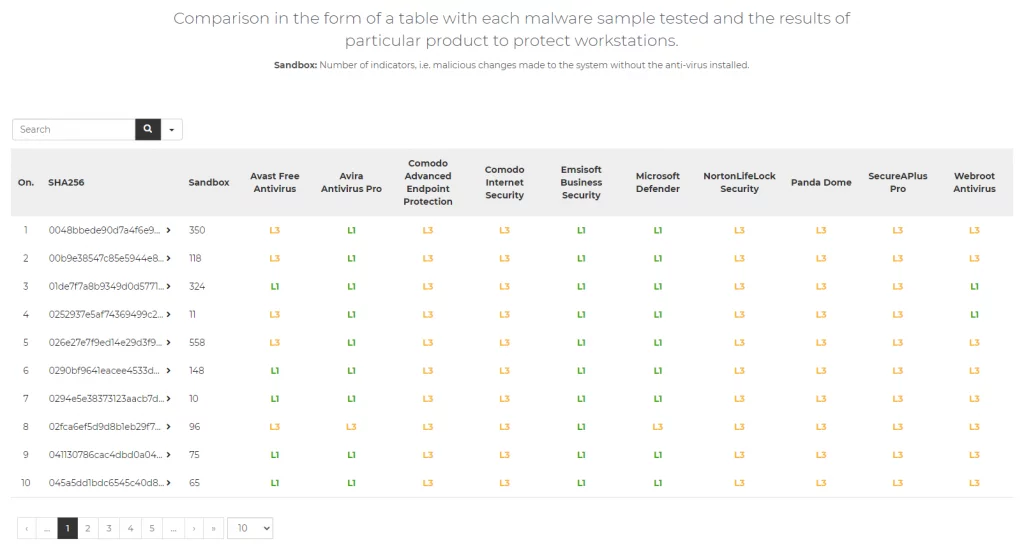March 2021 passed in which we were testing security products for the whole month as part of systematic studies called “The Advanced in The Wild Malware Test” that are comply with procedures and techniques of cyberattacks described in the MITRE ATT&CK bases.
Threat patterns that are presented in the form of matrices contain information on cybercrime techniques, and are used to develop specific methods of protection against targeted attacks called ATP. The MITRE base is used for research and development purposes by government and corporations related to cybersecurity services, and also to our AVLab organization – we translate into practice the accumulated in the MITRE base knowledge of hacker techniques when testing protection products.
March analysis of 10 security products continued uninterruptedly for the whole month, 24 hours a day. It is possible thanks to a programmed system that performs tedious calculations and actions in the Windows system, automating the entire test procedure (aggregating and analyzing logs, giving a verdict). The design and operation of this system are described in this article and in the methodology. In the test, we took into account these program versions that were suggested by developers. Here is the full list of tested solutions (in alphabetical order):
- Avast Free Antivirus
- Avira Antivirus Pro
- Comodo Advanced Endpoint Protection
- Comodo Internet Security
- Emsisoft Business Security
- Microsoft Defender
- NortonLifeLock Security
- Panda Dome
- SecureAPlus Pro
- Webroot Antivirus
The products and Windows 10 settings: daily test cycle
Tests are carried out in Windows 10 Pro x64. The user account control (UAC) is disabled because the purpose of the tests is to check the protection effectiveness of a product against malware, and not a reaction of the testing system to Windows messages. Other Windows settings remain unchanged.
The Windows 10 system contains installed the following software: office suite, document browser, email client, and other tools and files that give the impression of a normal working environment.
Automatic updates of the Windows 10 system are disabled in a given month of the tests. Due to the possibility of a malfunction, Windows 10 is updated every few weeks under close supervision.
Security products are updated one time within a day. Before tests are run, virus databases and protection product files are updated. This means that the latest versions of protection products are tested every day. All antivirus applications had access to the Internet during the tests.
Malicious software
In March, we used 1155 malware samples for the test, consisting of, among others, banking trojans, ransomware, backdoors, downloaders, and macro viruses. In the contrast to well-known testing institutions, our tests are much more transparent – we share the full list of harmful software samples.
VirusTotal versus real working environment
We use real working environments of Windows 10 in a graphic mode, that is why the results of individual samples may differ from those presented by the VirusTotal service. We point that out because inquisitive users may compare our tests with the scan results on the VirusTotal website. It turns out that differences between real products installed on Windows 10 and scan engines on VirusTotal are significant.
Levels of blocking malicious software samples
We share checksums of malicious software for researchers and security enthusiasts by dividing them into protection technologies that have contributed to detect and stop a threat. According to independent experts, this type of innovative approach of comparing security will contribute to better understand differences between products available on the market.
Each malware sample blocked by tested protection solution has been divided into few levels:
- Level 1 (L1): The browser level, i.e. a virus has been stopped before or after it has been downloaded onto a hard drive.
- Level 2 (L2): The system level, i.e. a virus has been downloaded, but it has not been allowed to run.
- Level 3 (L3): The analysis level, i.e. a virus has been run and blocked by a tested product.
- Failure (F): The failure, i.e. a virus has not been blocked and it has infected a system.
The latest result of blocking each sample are available at https://avlab.pl/en/recent-results/ in the table:

Summary
In March 2021 only one solution, Panda Dome, didn’t receive the maximum score of protection. According to our methodology, this antivirus designed for Windows 10 has failed to block 2 samples of malicious software. Other products to protect workstations were characterized by the maximum level of detection and blocking malicious software.
In some cases, differences between preventive and behavioral technologies in products are so significant that we had to show them in a table, and also mark them accordingly with the P1, P2, P3 levels.
We want to thank all interested developers for their quick response to the reported technical details, and assistance in seamless automation of our tests and their antivirus products.